GRP (Glass Reinforced Plastic) pipe seals are critical components used in various industries and applications to ensure the integrity and performance of GRP pipes. These seals play a crucial role in preventing leaks, maintaining pressure, and safeguarding the environment in a wide range of settings, from water and wastewater treatment plants to chemical processing facilities, oil and gas pipelines, and beyond. To provide a comprehensive understanding of GRP pipe seals, it’s essential to delve into a detailed description of their construction, function, benefits, and applications.
Construction and Materials:
GRP pipe seals are typically composed of high-quality materials that exhibit exceptional resistance to corrosion, chemicals, and environmental factors. These materials often include:
- GRP (Glass Reinforced Plastic): The core material of the pipe itself is usually made of GRP, known for its robustness, durability, and resistance to rust and degradation. GRP is a composite material composed of layers of fiberglass reinforced with a polymer resin matrix.
- Elastomeric Sealing Elements: The sealing portion of the GRP pipe seal is usually made of elastomeric materials like EPDM (Ethylene Propylene Diene Monomer), Nitrile, or Viton, depending on the specific requirements of the application. These elastomers provide a flexible and resilient sealing mechanism.
- Flanges and Fasteners: GRP pipe seals often come with flanges made of materials like stainless steel or carbon steel, which provide a robust connection point for the seal. Fasteners such as bolts and nuts are used to secure the seal in place.
Function and Benefits:
GRP pipe seals serve several crucial functions in industrial and municipal settings:
- Leak Prevention: The primary function of GRP pipe seals is to create a secure and watertight connection between GRP pipes, preventing leaks and the escape of hazardous substances.
- Pressure Containment: These seals ensure that the pressure within the pipes remains consistent and within safe limits, even under challenging conditions.
- Corrosion Resistance: GRP pipe seals are highly resistant to corrosion, making them suitable for use in aggressive environments where corrosion is a significant concern.
- Chemical Resistance: Depending on the elastomeric material used, GRP pipe seals can resist a wide range of chemicals, making them ideal for use in chemical processing plants and industries with corrosive substances.
- Temperature Tolerance: They can withstand a wide range of temperatures, making them suitable for both hot and cold fluid transport.
- Easy Installation: The design of GRP pipe seals allows for relatively easy installation, reducing labor costs and downtime during maintenance or installation processes.
Applications:
GRP pipe seals find applications in a diverse range of industries and settings, including:
- Water and Wastewater Treatment: These seals are commonly used in water treatment plants, sewage systems, and drainage systems.
- Oil and Gas Industry: GRP pipe seals are utilized in oil and gas pipelines and facilities for their corrosion resistance and durability.
- Chemical Processing: Industries dealing with corrosive chemicals rely on these seals to maintain the integrity of their piping systems.
- Marine and Offshore: GRP pipe seals are suitable for marine and offshore applications due to their resistance to saltwater and harsh environmental conditions.
- Industrial Manufacturing: Various manufacturing processes that involve the transportation of fluids utilize GRP pipes and seals to maintain operational efficiency.
In conclusion, GRP pipe seals are essential components that ensure the reliability and safety of GRP piping systems across multiple industries. Their robust construction, sealing capabilities, and resistance to corrosion and chemicals make them indispensable for maintaining fluid transport systems’ integrity while mitigating environmental risks. These versatile seals continue to play a vital role in modern infrastructure and industry.







